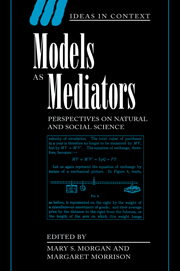Book contents
- Frontmatter
- Contents
- List of contributors
- Preface
- 1 Introduction
- 2 Models as mediating instruments
- 3 Models as autonomous agents
- 4 Built-in justification
- 5 The Ising model, computer simulation, and universal physics
- 6 Techniques of modelling and paper-tools in classical chemistry
- 7 The role of models in the application of scientific theories: epistemological implications
- 8 Knife-edge caricature modelling: the case of Marx's Reproduction Schema
- 9 Models and the limits of theory: quantum Hamiltonians and the BCS models of superconductivity
- 10 Past measurements and future prediction
- 11 Models and stories in hadron physics
- 12 Learning from models
- Index
9 - Models and the limits of theory: quantum Hamiltonians and the BCS models of superconductivity
Published online by Cambridge University Press: 10 March 2010
- Frontmatter
- Contents
- List of contributors
- Preface
- 1 Introduction
- 2 Models as mediating instruments
- 3 Models as autonomous agents
- 4 Built-in justification
- 5 The Ising model, computer simulation, and universal physics
- 6 Techniques of modelling and paper-tools in classical chemistry
- 7 The role of models in the application of scientific theories: epistemological implications
- 8 Knife-edge caricature modelling: the case of Marx's Reproduction Schema
- 9 Models and the limits of theory: quantum Hamiltonians and the BCS models of superconductivity
- 10 Past measurements and future prediction
- 11 Models and stories in hadron physics
- 12 Learning from models
- Index
Summary
INTRODUCTION
In the 1960s when studies of theory change were in their heyday, models were no part of theory. Nor did they figure in how we represent what happens in the world. Theory represented the world. Models were there to tell us how to change theory. Their role was heuristic, whether informally, as in Mary Hesse's neutral and negative analogies, or as part of the paraphernalia of a more formally laid out research programme, as with Imré Lakatos. The 1960s were also the heyday of what Fred Suppe (1977) dubbed ‘the received view’ of theory, the axiomatic view. Theory itself was supposed to be a formal system of internal principles on the one hand – axioms and theorems – and of bridge principles on the other, principles meant to interpret the concepts of the theory, which are only partially defined by the axioms. With the realisation that axiom systems expressed in some one or another formal language are too limited in their expressive power and too bound to the language in which they are formulated, models came to be central to theory – they came to constitute theory. On the semantic view of theories, theories are sets of models. The sets must be precisely delimited in some way or another, but we do not need to confine ourselves to any formal language in specifying exactly what the models are that constitute the theory.
Although doctrines about the relation of models to theory changed from the 1960s to the 1980s, the dominant view of what theories do did not change: theories represent what happens in the world.
- Type
- Chapter
- Information
- Models as MediatorsPerspectives on Natural and Social Science, pp. 241 - 281Publisher: Cambridge University PressPrint publication year: 1999
- 30
- Cited by

